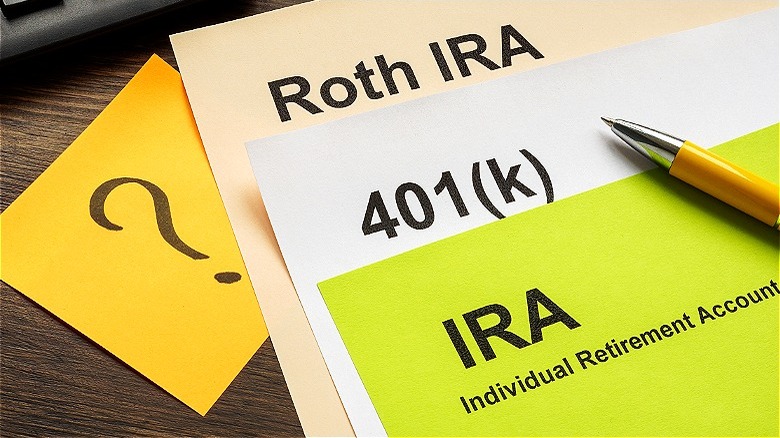How To Open An IRA
Whether you're looking to supplement your workplace retirement option or you're looking to start saving for retirement entirely on your own, an individual retirement account, or IRA, can be a great option. Unlike 401(k) plans, which are traditionally only available through workplace plans, IRAs are available to just about anyone, which can make them a more accessible option for those without workplace plans to rely on. While financially planning your retirement might not be the most fun thing to spend time on, it's incredibly important to realize how and when you should start saving for retirement.
For starters, IRAs are investment accounts that are tax-advantaged in some way. This can mean they're either tax-free or tax-deferred, depending on the account. This means you can choose to have your contributions taxed only after you eventually remove them from the account (deferred) or you can use after-tax money to contribute to the account in the first place (tax-free). Some important things to realize about IRA accounts are that they're subject to annual contribution limits, meaning you can only contribute up to a certain amount every year. In 2024, the contribution limit for those under age 50 is $7,000 while the limit for those over 50 is $8,000.
Once you've decided on opening an IRA, there can be a lot of initial questions to answer when deciding on the right account type for you. For instance, IRAs can be opened through a traditional bank, a broker, or even a robo-advisor.
Opening an IRA
Opening an individual retirement account is a relatively simple process, with most of the work involving making some important financial decisions depending on your comfort level and financial goals. For starters, deciding on just how involved you want to be with your investments can be an important thing to determine before signing up for any specific account. For those looking for a more hands-off and simplified approach, robo-advisors could be the best option as opposed to using a broker where you'd pick and choose your individual investments. In addition to deciding between using a broker or a robo-advisor, you'll also want to decide if you're interested in investing in stocks, bonds, exchange-traded funds, or any other kind of asset. These decisions can (and should be) determined by your risk aversion and investment comfort level. (Here's what you need to know before investing in ETFs.)
Once you've decided on your involvement and preferred investment focus, you can select a provider for your new IRA. Some important things to keep in mind are associated account fees, commissions, and transaction fees that might ultimately hurt your financial goals long-term. Some accounts might require minimums, as well as minimum amounts for specific investments so it's important to do your homework on a provider before opening an account with them. If you're someone who prefers the robo-advisor route, make sure to still familiarize yourself with your access to actual human financial advisers in case of any issues. Most robo-advisor provider companies have varying access to actual people so make sure it's easy enough to speak with someone should you need to.
Other things to consider
Once you've selected a provider that fits your needs and financial goals, opening an IRA savings account is generally a simple online process that involves providing some basic personal details such as your birthday, Social Security number, and employment information. Once your account is open, you'll need to fund the account. This money can come from a myriad of different places including from existing IRA assets at a different provider, or funds rolled over from your 401(k).
Another important decision can be deciding between Roth IRAs and traditional ones. With different tax outcomes and withdrawal penalties, it can be worth researching which kind of IRA might be best for you. It's also worth mentioning that the limitations of an IRA simply might not be the best fit for your retirement goals (especially when it comes to contribution limits and when you begin to save), so it's also worth investigating if a 401(k) or IRA might be a better choice for you overall.
Remember that 401(k) contribution limits were $23,000 in 2024, so viewing an IRA account as a supplemental way to save more for retirement might be the smarter financial decision then relying entirely on an IRA for your retirement savings. However, while contribution limits can obviously be significant, especially to long-term savings goals like your retirement, it's also important to compare things like account fees and the flexibility available to you in choosing where your money goes. Ultimately, finding the right retirement account for your individual needs and goals is the most important factor.


